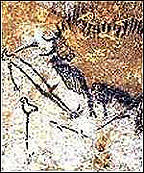 A prehistoric map of the night sky has been discovered on the walls of the famous painted caves at
A prehistoric map of the night sky has been discovered on the walls of the famous painted caves at The map, which is thought by scientists to date back 16,500 years, shows three bright stars known today as the Summer Triangle.
A map of the Pleiades star cluster has also been found among the
According to German researcher Dr Michael Rappenglueck, of the
The
The caves could be a prehistoric planetarium in which humanity first charted the stars. The sky map has been found in a region of the
According to Dr Rappenglueck, these outlines form a map of the sky with the eyes of the bull, birdman and bird representing the three prominent stars Vega, Deneb and Altair. Taken together, these stars are popularly known as the Summer Triangle and are among the brightest objects that can be picked out high overhead during the middle months of the northern summer.
Around 17,000 years ago, this region of sky would never have set below the horizon and would have been especially prominent at the start of spring.
"It is a map of the prehistoric cosmos," Dr Rappenglueck told BBC News Online. "It was their sky, full of animals and spirit guides."
But the sky map is not the only evidence that prehistoric man took a keen interest in the night sky. Nearer to the entrance of the  what appears to be a map of the Pleiades, the cluster of stars sometimes called the Seven Sisters. Inside the bull painting, there are also indications of spots that may be a representation of other stars found in that region of sky.
what appears to be a map of the Pleiades, the cluster of stars sometimes called the Seven Sisters. Inside the bull painting, there are also indications of spots that may be a representation of other stars found in that region of sky.
Today, this region forms part of the constellation of Taurus the bull, showing that mankind's identification of this part of the sky stretches back thousands of years.
Dr Rappenglueck has also identified a star map painted on the walls of a cave in
"Nobody paid much attention to it," said Dr Rappenglueck. "But, it is obviously a drawing of the constellation we call the Northern Crown. It is remarkable."
The archaeologists who have looked at Dr Rappengleuck's conclusions have so far agreed that they are reasonable and that he may have uncovered the earliest evidence of humanity's interest in the stars.
This is kind of cool, the same kind of things that interest us today may have also interested our Great Great Great Great Great Great Great Great Great Great Great Great Great Great Great Great Great Great Great Great Great Great Great Great Great Great Great Great Great Great Great Great Great Great Great Great Great Great Great Great Great Great Great Great Great Great Great Great Great Great Great Great Great Great Great Great Great Great Great Great Great Great Great Great Great Great Great Great Great Great Great Great grand parents! Just another reason to keep an open mind and to keep walking in this big Weird World of ours.
I’m Average Joe


No comments:
Post a Comment